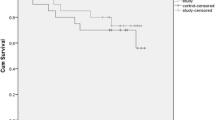Background:
Comprehensive literature on cervical cancer demonstrates, even today, the need for optimization of the timing of external-beam radiotherapy (EBRT) and high-dose-rate brachytherapy (HDR-BT) in the treatment of stage IIA/B–IIIB cervical carcinoma.
Patients and Methods:
210 patients with carcinoma of the cervix were treated in the Municipal Center of Oncoradiology between January 1991 and December 1996 (FIGO IIA: n = 10, FIGO IIB: n = 113, and FIGO IIIB: n = 87). Two regimens were compared: sequential radiation therapy (SRT) with 4 × 8 Gy HDR-BT to point A followed by EBRT, and continuous radiation therapy (CRT) in which 5 × 6 Gy HDR-BT to point A, one session per week, was integrated into the EBRT. A total dose of 68–70 Gy to point A and 52–54 Gy to point B was given in EBRT with SRT, five fractions per week were applied. Four fractions per week were applied in CRT, i. e., no EBRT was performed on the day of HDR-BT. Total doses to points A and B were identical in both regimens. Overall treatment time (OTT) amounted to 56 days for SRT and 35 days for CRT. Median follow-up time was 3.4 (2.5–4.2) years.
Results:
Progression-free 5-year-survival (PFS) was 71% in the CRT and 56% in the SRT group. Nevertheless, this difference was not statistically significant (p = 1.00), and the same was found in a subgroup analysis of the different tumor stages, showing, however, an unequivocal trend. Late bladder and rectal injuries occurred in 13% and 25%, respectively. Late rectal injuries were significantly more frequent with SRT than CRT (35 patients in the SRT and 18 patients in the CRT group; p = 0.037). This was due to the higher doses per fraction of HDR-BT in the SRT group. No difference was found regarding late bladder injuries (p = 0.837).
Conclusion:
For the patients included in this study, no advantage has been found so far in using CRT, i. e., shortening the OTT by weekly integration of HDR-BT into EBRT. Nevertheless, an obvious trend exists. The dose of 8 Gy per fraction of HDR-BT in the SRT regimen was obviously too high. To achieve a significant improvement in local control and disease-free survival (DFS) as well as overall survival (OS), the combination with modern chemotherapy regimens and regional deep hyperthermia may rather be the treatment option.
Hintergrund:
Die umfangreiche Literatur zum Zervixkarzinom belegt, dass auch heute noch Optimierungsbedarf bezüglich der räumlichen und zeitlichen Interaktion von perkutaner Strahlentherapie (EBRT) und High-Dose-Rate-Brachytherapie (HDR-BT) bei der Behandlung des Zervixkarzinoms im Stadium IIA/B–IIIB besteht.
Patienten und Methodik:
Zwischen Januar 1991 und Dezember 1996 wurden 210 Patientinnen mit einem Zervixkarzinom FIGO IIA/B–IIIB am Uzsoki Hospital, Budapest, Ungarn, behandelt (FIGO IIA: n = 10, FIGO IIB n = 113 und FIGO IIIB n = 87). Zwei kombinierte Strahlentherapieregime wurden verglichen: eine sequentielle Therapie (SRT) mit 4 × 8 Gy HDR-BT am Punkt A, gefolgt von EBRT, und eine kontinuierliche Therapie (CRT), bei der die wöchentliche HDR-BT mit 5 × 6 Gy am Punkt A in die EBRT integriert war. Die EBRT erfolgte bei SRT fünfmal wöchentlich bis zu einer Gesamtdosis von 68–70 Gy am Punkt A und 52–54 Gy am Punkt B. Bei der CRT wurde viermal wöchentlich perkutan bestrahlt, d. h. nicht am Tag der HDR-BT. Die Gesamtdosen am Punkt A bzw. B waren bei beiden Regimen gleich. Die Gesamtbehandlungszeit (OTT) betrug bei SRT 56 Tage, bei CRT 35 Tage. Die mediane Nachbeobachtungszeit lag bei 3,4 (2,5–4,2) Jahren.
Ergebnisse:
Das progressionsfreie 5-Jahres-Überleben (DFS) betrug in der CRT-Gruppe 71% und in der SRT-Gruppe 56%. Dieser Unterschied erreichte allerdings keine statistische Signifikanz (p = 1,00), auch nicht in Untergruppenanalysen der einzelnen Tumorstadien. Der Trend war jedoch eindeutig. Spätfolgen an Blase und Rektum traten in 13% bzw. 25% auf. Die Spätfolgen am Rektum waren bei SRT statistisch signifikant häufiger als bei CRT (35 Patienten bei SRT und 18 Patienten bei CRT; p = 0,037). Dies wird auf die höhere HDR-BT-Fraktionsdosis bei SRT zurückgeführt. Bei den Spätfolgen an der Blase ergab sich kein Unterschied (p = 0,837).
Schlussfolgerung:
Bisher ist in dem hier vorgestellten Patientengut kein günstiger Effekt der CRT mit wöchentlich in die EBRT integrierter HDR-BT und verkürzter OTT nachweisbar; es besteht lediglich ein Trend. Die HDR-BT-Fraktionsdosis war im SRT-Regime mit 8 Gy zu hoch. Eine signifikante Verbesserung der lokalen Kontrollrate und der krankheitsfreien bzw. Gesamt-Überlebenszeit ist wohl nur durch die Kombination mit modernen chemotherapeutischen Regimen und der regionalen Tiefenhyperthermie erreichbar.
Similar content being viewed by others
Author information
Authors and Affiliations
Corresponding author
Rights and permissions
About this article
Cite this article
Mayer, Á., Nemeskéri, C., Petneházi, C. et al. Primary Radiotherapy of Stage IIA/B–IIIB Cervical Carcinoma. Strahlenther Onkol 180, 209–215 (2004). https://doi.org/10.1007/s00066-004-1122-8
Received:
Revised:
Issue Date:
DOI: https://doi.org/10.1007/s00066-004-1122-8
Key Words:
- Cervical cancer
- High-dose-rate brachytherapy
- Sequential regimen
- Continuous regimen
- Overall treatment time
- Locoregional control
- Late side effects




